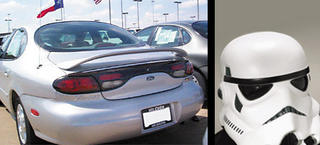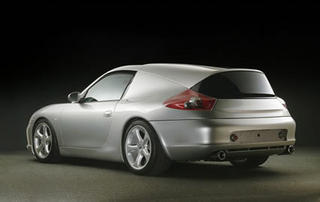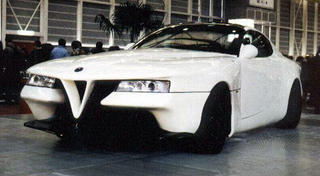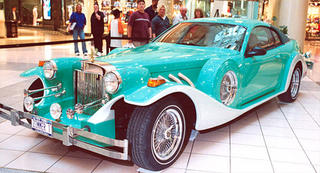
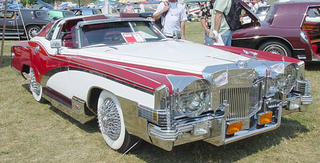



SWEET MOTHER OF GOD.
This one is much worse than it's sister the Cabalista. Believe it or not it's actually a Corvette too. But with a Cadillac Eldorado front and rear tacked on. And then they were much modified. This is like fugly overload. And these things were FOR SALE. And people BOUGHT THEM.
Lets see... The front is actually a take on a Stutz (another neoclassic) I think, with the huge round "headlights". Or chrome disks hiding the real headlights. Actually chrome is a continuing theme. Practically every vertical piece of body has a huge piece of chrome on it. Oddly the customary neoclassic side exhausts are sorta rectangular in shape. I'm not sure why - it just makes them bigger and uglier. Also note the hubcaps - they stick out so far they look like wire whisks. Handy for making whipped cream on the road? Or tenderizing roadkill?
Also looking at the side view, you can tell that a Corvette has a much shorter length stock than the Eldorado, and has a much shorter wheelbase. After the pieces are stuck on it looks like the wheels have been pushed as close to the centre as possible.
The rear end is so full of crap I don't know what to talk about. But I noticed one thing which got me thinking. The "trunk" has tie straps, which many neo-classics have as a throw back to when trunks had no latches but were tied shut using similar looking straps. BUT - the Corvette had no trunk. Just the glass/plexiglass hatch. One reason they did this was to keep the fuel filler/Corvette logo in the centre of the trunk. You can see the filler is still clearly in the centre of the trunk area. So does this mean that under the miles of metal rear of the roof is empty space that can't be used? That's efficient.
Ok - I have to stop looking at this or I'm going to have a seisure.





